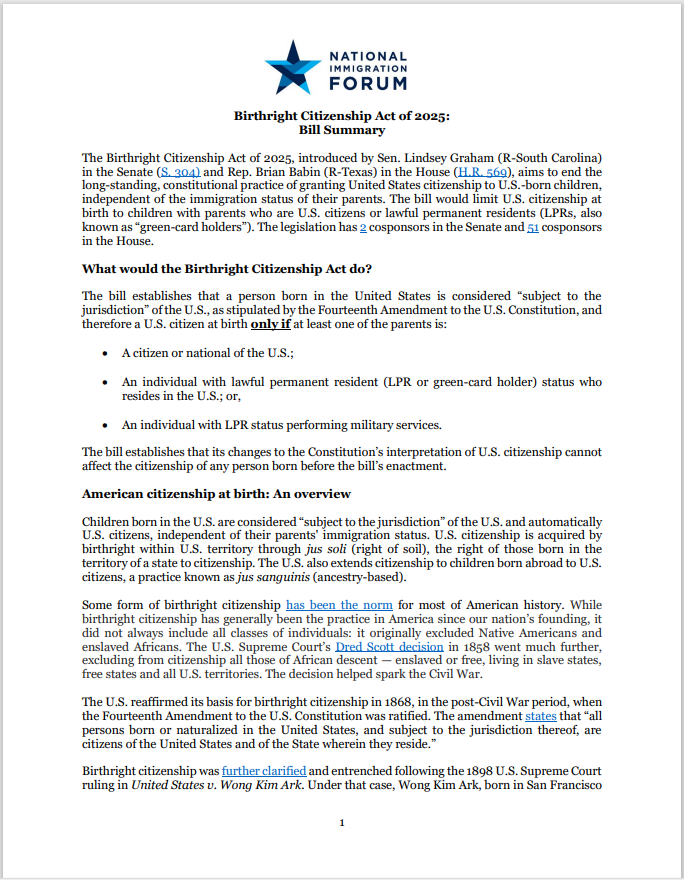
The Birthright Citizenship Act of 2025, introduced by Sen. Lindsey Graham (R-South Carolina) in the Senate (S. 304) and Rep. Brian Babin (R-Texas) in the House (H.R. 569), aims to end the long-standing, constitutional practice of granting United States citizenship to U.S.-born children, independent of the immigration status of their parents. The bill would limit U.S. citizenship at birth to children with parents who are U.S. citizens or lawful permanent residents (LPRs, also known as “green-card holders”). The legislation has 2 cosponsors in the Senate and 51 cosponsors in the House.
What would the Birthright Citizenship Act do?
The bill establishes that a person born in the United States is considered “subject to the jurisdiction” of the U.S., as stipulated by the Fourteenth Amendment to the U.S. Constitution, and therefore a U.S. citizen at birth only if at least one of the parents is:
- A citizen or national of the U.S.;
- An individual with lawful permanent resident (LPR or green-card holder) status who resides in the U.S.; or,
- An individual with LPR status performing military services.
The bill establishes that its changes to the Constitution’s interpretation of U.S. citizenship cannot affect the citizenship of any person born before the bill’s enactment.
American citizenship at birth: An overview
Children born in the U.S. are considered “subject to the jurisdiction” of the U.S. and automatically U.S. citizens, independent of their parents’ immigration status. U.S. citizenship is acquired by birthright within U.S. territory through jus soli (right of soil), the right of those born in the territory of a state to citizenship. The U.S. also extends citizenship to children born abroad to U.S. citizens, a practice known as jus sanguinis (ancestry-based).
Some form of birthright citizenship has been the norm for most of American history. While birthright citizenship has generally been the practice in America since our nation’s founding, it did not always include all classes of individuals: it originally excluded Native Americans and enslaved Africans. The U.S. Supreme Court’s Dred Scott decision in 1858 went much further, excluding from citizenship all those of African descent — enslaved or free, living in slave states, free states and all U.S. territories. The decision helped spark the Civil War.
The U.S. reaffirmed its basis for birthright citizenship in 1868, in the post-Civil War period, when the Fourteenth Amendment to the U.S. Constitution was ratified. The amendment states that “all persons born or naturalized in the United States, and subject to the jurisdiction thereof, are citizens of the United States and of the State wherein they reside.”
Birthright citizenship was further clarified and entrenched following the 1898 U.S. Supreme Court ruling in United States v. Wong Kim Ark. Under that case, Wong Kim Ark, born in San Francisco to Chinese parents, was denied re-entry into the US after a trip abroad on the grounds that he was not a citizen. In a landmark 6-2 decision, the Supreme Court ruled he was indeed a U.S. citizen under the Fourteenth Amendment. This established the explicit precedent that, with limited exceptions for the families of diplomats, anyone born in the U.S. is automatically a U.S. citizen at birth.
Opponents of birthright citizenship have focused on the Fourteenth Amendment phrase “and subject to the jurisdiction thereof” as a disqualifier for children born to parents who were not U.S. citizens or LPRs at the time of their birth. They argue that those individuals are not subject to “complete, political jurisdiction” of the United States, but merely to “partial, territorial jurisdiction.” Today, the phrase “subject to the jurisdiction thereof” is limited to excluding children from U.S. citizenship if the child’s parents are foreign diplomats or under the “official capacity” of another foreign government.Critics of birthright citizenship also generally argue that the policy incentivizes unlawful immigration practices, citing “birth tourism” as an example, though it is unclear how often this happens.
The Birthright Citizenship Act of 2025 mirrors the objectives of President Donald Trump’s executive action, “Protecting the Meaning and Value of American Citizenship,” which was issued on January 20, 2025. This action aims to restrict birthright citizenship not only for children born to undocumented parents, but also for those born to parents who are in the U.S. temporarily, such as through a work or tourist visa. As of March 2025, the order has been temporarily blocked by four different federal judges across the country.
Impacts of the bill
The Birthright Citizenship Act of 2025 would have significant impacts on U.S. society if passed by Congress. These impacts include:
Increases in undocumented and stateless people: An analysis by the Migration Policy Institute (MPI) found that “ending birthright citizenship for U.S. babies with two unauthorized immigrant parents would increase the existing unauthorized population by 4.7 million people by 2050.” The Birthright Citizenship Act would likely increase the number of undocumented and/or stateless people in the United States, as many children born in the U.S. to immigrant parents would exist in a legal limbo — not having citizenship in the United States, nor (in some cases) in the country of their parents’ birth.
Second-class status: These communities would essentially have second-class status in U.S. society. They would not be able to access passports or identification documents (including driver’s licenses). They may also face barriers to higher education, obtaining health insurance, and the ability to work legally in the U.S. There are currently several countries that do not offer full birthright citizenship. Among those countries, Germany presents an interesting case study to examine the effects of limiting birthright citizenship and what happens when just some of those restrictions are lifted. According to a report by the CATO Institute:
“[The] German Citizenship and Nationality Law of 1913 only granted citizenship to those with at least one parent who was a German citizen at the time of the child’s birth…German-born noncitizens formed “parallel societies” and were more prone to crime and political radicalism than German-born German citizens.”
In contrast, the report notes, when Germany amended the 1913 law to create birthright citizenship for children born on or after January 1, 2000, if at least one parent had resided in Germany for at least eight years, Germany saw improvements in immigrant assimilation, including German fluency and the number of people reading German newspapers.
Economic implications: Ending birthright citizenship would create an extensive tangle of bureaucratic hurdles, including necessitating a system to determine which babies born in the U.S. do and do not qualify for citizenship. This would add to government bloat and likely be extraordinarily expensive; it could also result in delays and errors in obtaining proof of citizenship, and people could be denied their rightful citizenship because of mistakes in the system. Over time, as more and more children born in the U.S. to undocumented parents age into the work force, these capable young people would be ineligible to work due their undocumented status, creating barriers to contributing to their communities and the economy.
Unequal treatment: The Birthright Citizenship Act of 2025 would maintain people’s U.S. citizenship if they were born before the bill’s enactment. This would create a deep, arbitrary inequity in the country moving forward – a tiered system of citizenship where some people born to non-citizens/non-LPRs before the bill’s enactment are U.S. citizens, but others (born after the bill’s enactment) are not. Case in point, two babies born to undocumented parents but born a few days apart (before and after the bill’s enactment) could face drastically different futures; one would be born a U.S. citizen and the other would not. The legislation arbitrarily draws a line, which would undermine the essential American constitutional promise of equal treatment under the law.
.
.
The National Immigration Forum would like to thank Katia Diamond-Sagias, Policy and Advocacy intern, for developing and writing this explainer.


